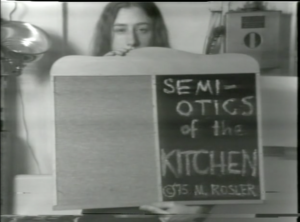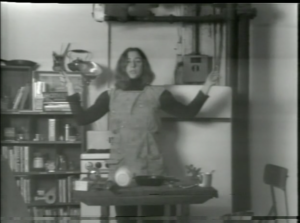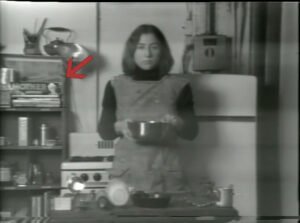Martha Rosler, Semiotics of the Kitchen, 1975, video, 6 minutes and 9 seconds © Martha Rosler
Absurdist cooking
There is something about cooking shows that makes them comforting to watch. Perhaps, it’s the calm of the television kitchen set—one without the clamor and clang of family or friends anxiously awaiting whatever is being prepared—or the simplification of a complex recipe into clear and discrete steps, ones that you too can easily complete. Or, maybe, it’s just the pleasure of seeing a perfectly composed dish being served at the end. No matter what, cooking shows are satisfyingly calming television.
But in 1975, Martha Rosler created her own version of the television cooking show, one that sought to unsettle and disturb her audiences, to jolt them awake and make them take a different kind of action far from the stove. The oscillation between Rosler’s deadpan naming of each kitchen implement and the rage expressed in it’s demonstration unsettles the presumption of cooking as a calm activity done as a form of caretaking, especially when performed by women in the context of the home. Instead of inspiring her audience to cook, Rosler used her piece to critique the relationship between cooking and womanhood. In the approximately 6-minute video, Semiotics of the Kitchen, Rosler creates a parody of a cooking demonstration modeled partly on television programs like Julia Child’s The French Chef (airing 1963–73) and on “late-night commercials” for trendy kitchen gadgets. Rosler, however, lists off different cooking implements, one for almost every letter of the alphabet, portraying absurd, even violent uses for each item.
Rosler’s desire to parody a cooking show was born out of her engagement with various feminist groups in New York and San Diego during the 1960s and 1970s, a period known as “Second-wave” Feminism. Feminist activists built their work around the idea that “the personal is political” and engaged in “consciousness raising” efforts, in which women would share their experiences with sexism in daily life with one another in order to make clear that these issues are structural, and not individual. Within the art world, countless women artists began using consciousness-raising and other feminist tactics in their practices, making work that focuses on gender inequality in its various forms from the most overt—the exclusion of women from the history of art and from the major venues of the art world—to the more subtle, such as the presumption that cooking is a natural proclivity of all women, rather than actually being a form of learned and skilled labor.

Still from Martha Rosler, Semiotics of the Kitchen, 1975, video, 6 minutes and 9 seconds © Martha Rosler
Low-tech satire
Semiotics of the Kitchen begins with a shot of Rosler standing behind a table in a sparse kitchen, holding a board with the words “Semi-otics of the Kitchen © ‘75 M. Rosler” written on them. Behind her we see a stove, a refrigerator, and a bookshelf with various pantry items, cookwares, books, and decorative objects. In front of Rosler are a variety of culinary implements, splayed across the table. Rosler puts down the sign and the camera pans back as Rosler dons a simple kitchen smock and says the word “Apron” to begin her own version of a cooking demonstration.
Instead of showing how to prepare a dish or enact a particular technique, Rosler lists items found in a household kitchen, alphabetically, while pantomiming a possible use for each object. Her gestures, however, are far from the typical application of each appliance. For instance, instead of demonstrating a chopping technique when she says the word “Knife” as the implement for the letter “K,” Rosler grasps the handle with a reverse grip and stabs the air, violently, several times. Similarly, when she says the word “Rolling Pin” for the letter “R,” she raises the rolling pin to chest height and aggressively moves the object forward and back, as if she were about to throw and catch the pin; the result of which is her whole body aggressively jerking back and forth.
Rosler uses several of the cooking implements to make loud noises, such as when she repeatedly opens and shuts a “Hamburger press” so that it mimics the sound of castanets or when she drops a “Chopper”—a mezzaluna knife with a rounded handle—into a metal bowl causing them to clang loudly. She also incorporates nonsensical and even bizarre pantomimes, such as when she pretends to throw the contents of a “Ladle,” “Measuring Implements,” and “Spoon” over her shoulder.

Still from Martha Rosler, Semiotics of the Kitchen, 1975, video, 6 minutes and 9 seconds © Martha Rosler
Rosler carries on her pantomime until she reaches the letter “U,” at which point she picks up a carving fork and a knife and makes the shape of the letters “U, V, W, X, [and] Y” with her hands and body. She ends the video by taking the knife and cutting a “Z” in the air, much like the late 1950s television character Zorro, before putting the knife and fork down and folding her arms. The result is a video that is framed like a cooking show, but involves no meaningful instruction aside from an alphabetized list of kitchen gadgets.
Through demonstrating various culinary implements, Rosler used her video to unsettle the relationship between womanhood and the kitchen, especially with regard to the gendered labor of cooking. By creating an absurdist version of a cooking show—one that is guided by the alphabet rather than a recipe, and one in which all of the actions are loud, jerky, and filled with unease—Rosler illustrates that cooking is not a natural proclivity of all women, but is rather a learned form of skilled labor. Moreover, by presenting alternative uses, albeit often ridiculous ones, for the various cooking implements she demonstrates in this video, Rosler illuminates the fact that there are multiple meanings present for each word.
Feminist language
While Semiotics of the Kitchen is, on its surface, a parody of a cooking show, the work is about much more than the mundane items being demonstrated. As the title suggests, Semiotics of the Kitchen, is about the signification of these objects. For Rosler, demonstrating each implement alphabetically and undermining the conventional usage of the various devices is meant to illustrate the value and meaning we attach to each of these items. The focus on the relationship between an object and its meaning drew from Semiotics, a branch of Linguistics and an important aspect of 20th-century literary theory.
Rosler has long been interested in the implications of certain words and language systems, and what meanings they have. For instance, in her 1974 work The Bowery in Two Inadequate Descriptive Systems, Rosler demonstrates the failure of language to communicate the lived experience of poverty and the impact of the Vietnam War—both in terms of the draft and with regard to the experience of veterans, many of whom returned to the U.S. struggling with addiction, mental illness, and the physical wounds of War—on the community of the Bowery in Manhattan.

Still from Martha Rosler, Semiotics of the Kitchen, 1975, video, 6 minutes and 9 seconds © Martha Rosler
“Semiotics of the Kitchen” examines the kitchen utensil as a sign that carries social meaning. For Rosler, an actively engaged and outspoken feminist, the kitchen was intertwined with the gender politics of the mid-20th century. The rhetoric of the Cold War led to a revitalization of the idea that women “belong in the home” and more specifically in the kitchen. Cooking programs in the 1950s and 1960s often reinforced this notion, focusing on presenting quick meals that mothers could make for their husbands and children. Rosler took aim at this focus in making her parody of a cooking show, and made the critique of housewives more explicit by including a placard on the shelf in the back that reads “Mother.”
In twisting the cooking show format and making it a work of conceptual art, Rosler brought serious attention to a subject that was often treated as frivolous and anti-intellectual. Her video offers a pointed critique of the underlying patriarchal assumption that treats domestic cooking as “women’s work” and thus unworthy of deep consideration. By pointing out the intrinsic violence and danger of a kitchen, Rosler complicates the gendered trope that cooking is inherently soft and feminine. As such, she uses the video to illustrate that language—words and relations—informs how we understand what items belong where and to whom, and how a semiotic system can either enforce or unsettle those very same presumptions.

